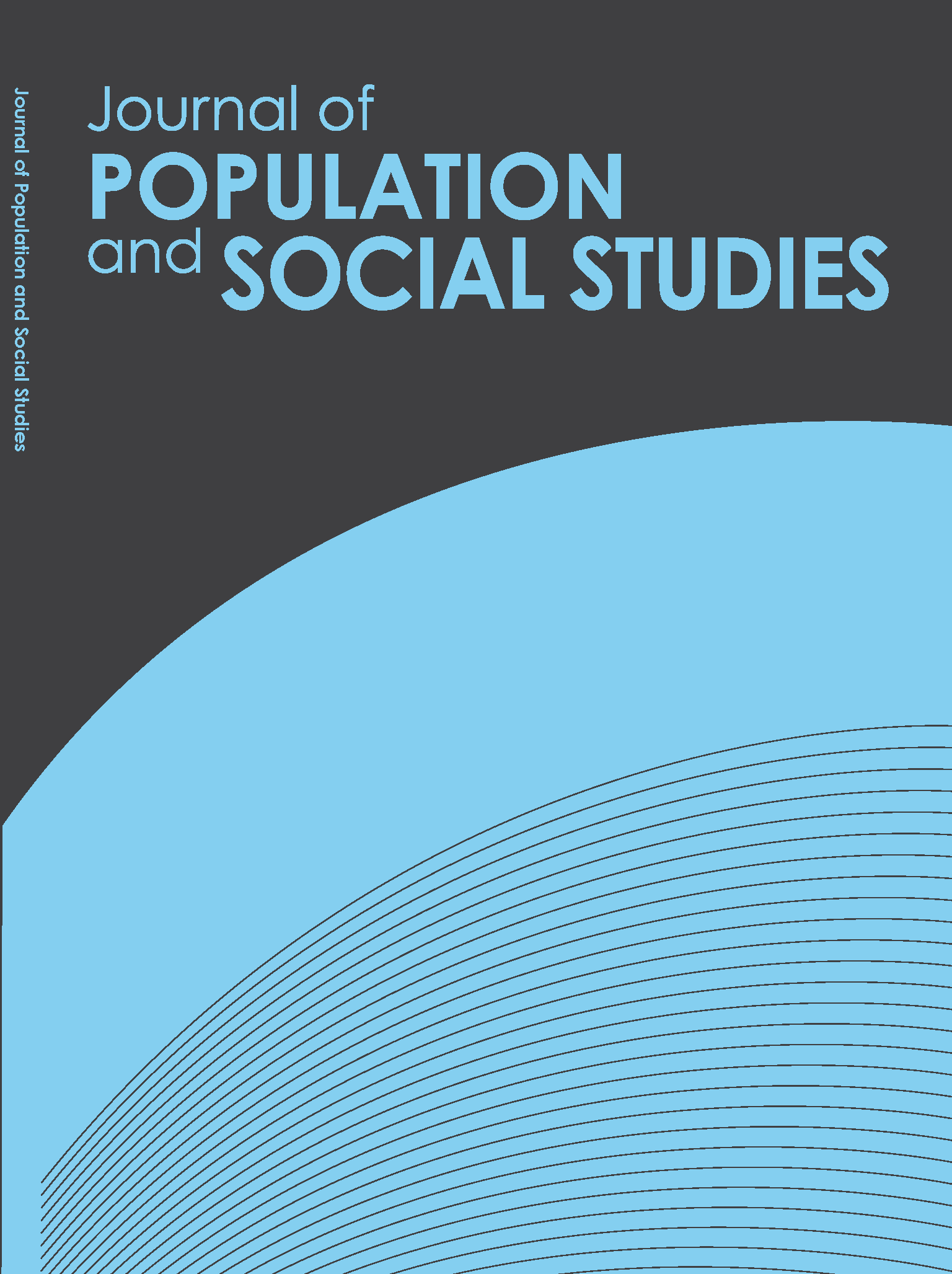Effects of Pregnant Mothers’ Work on First-Year Infant Deaths in a Thai Prospective Cohort
Main Article Content
Abstract
This study examines the relationship between mothers' work and infant death in Thailand. It estimates the survival probability at a given time using data from a prospective cohort study of Thai children during 2000-2002. A cohort of 4,245 infants was followed from 28-32 weeks gestation until one year of age. The study found that mother’s occupation had an independent relationship with infant death (p< 0.10). Infants of mothers with mid-level occupations during pregnancy showed a lower risk of death than those with lower level occupations (odds ratio = 0.42, p= 0.082). In addition, the Kaplan-Meier cumulative probabilities of survival support the finding that this difference occurred in the late-neonatal and post-neonatal periods. However other factors occurring during pregnancy and the neonatal period—namely a lack of attended antenatal care, low birthweight, preterm birth, perinatal hospitalization morbidity of the mother, income of the household head, and geographic area— also increased the risk of infant death. The findings indicate that the Thai government should be concerned about working conditions for female agricultural workers and construction laborers, and that pregnant women and their families should be encouraged to access both pre- and post-natal maternal and child health services, especially in the late and post-neonatal periods. Such measures would save infant lives and lower the infant mortality rate for Thailand.
Article Details
References
Arntzen, A., Samuelsen, S. O., Bakketeig, L. S., & Stoltenberg, C. (2004). Socioeconomic status and risk of infant death. A population-based study of trends in Norway, 1967–1998. International Journal of Epidemiology, 33(2), 279-288.
Beguy, D., Zulu, E. M., Muindi, K., Konseiga, A., & Yé, Y. (2011). Do migrant children face greater health hazards in slum settlements? Evidence from Nairobi, Kenya. Journal of Urban Health, 88(2), 266-281.
Chowdhury, Q. H., Islam, R., & Hossain, K. (2010). Socio-economic determinants of neonatal, post neonatal, infant and child mortality. International Journal of Sociology and Anthropology, 2(6), 118-125.
Campbell, O., Gipson, R., el-Mohandes, A., Issa, A. H., Matta, N., Mansour, E., et al. (2004). The Egypt National Perinatal/Neonatal Mortality Study 2000. Journal of Perinatology, 24(5), 284-289.
Dummer, T. J. B., & Parker, L. (2005). Changing socioeconomic inequality in infant mortality in Cumbria. Archives of Disease in Childhood, 90(2), 157-162.
Finch, B. K. (2003). Early origins of the gradient: The relationship between socioeconomic status and infant mortality in the United States. Demography, 40(4), 675-699.
Goel, M. K., Khanna, P., & Kishore, J. (2010). Understanding survival analysis: Kaplan-Meier estimate. International Journal of Ayurveda Research, 1(4), 274.
Jones, G. & Chandoevwit, W. (2011). Policy implications of Thailand’s population trends. In Jones, G. & Im-Em, W. (Eds.), Impact of demographic change in Thailand. (pp.115-130). Bangkok: United Nations Population Fund (UNFPA). Retrieved from http://thailand.unfpa.org/documents/symposium/Impact%20Full%20Report%20Eng%20UNFPA%20Web.pdf
Kelly, M., Strazdins, L., Ellora, T. D., Khamman, S., Seubsman, S.A., & Sleigh, A. C. (2010). Thailand's work and health transition. International Labour Review, 149(3), 373-386.
Kim, D., & Saada, A. (2013). The social determinants of infant mortality and birth outcomes in Western developed nations: A cross-country systematic review. International Journal of Environmental Research and Public Health, 10(6), 2296-2335.
Lewycka, S. O. (2010). Reducing maternal and neonatal deaths in rural Malawi: evaluating the impact of a community based women’s group intervention. (Unpublished doctoral dissertation). University College London, London.
Ministry of Labour of Thailand. (1998). Labor Protection Act, B.E. 2541 (1998). Legal Affairs Division, Department of Labour Protection and Welfare. Retrieved from http://www.labour.go.th/en/attachments/article/18/Labour_Protection_Act_BE1998.pdf
Mosley, W. H., & Chen, L. C. (1984). An analytical framework for the study of child survival in developing countries. Population and Development Review, 10(Supplement), 25-45.
Mo-suwan, L., Isaranurug, S., Chanvitan, P., Techasena, W., Sutra, S.,
Supakunpinyo, C., et al. (2009). Perinatal death pattern in the four districts of Thailand: Findings from the Prospective Cohort Study of Thai Children (PCTC). Journal of the Medical Association of Thailand, 92(5), 660-666.
National Statistical Office of Thailand. (1994). The labour force survey. Bangkok: Ministry of Information and Communication Technology. Retrieved from http://web.nso.go.th/en/survey/lfs/lfs_main.htm
National Statistical Office of Thailand. (2014, Jan 4). The labor force survey whole Kingdom quarter 1: January–March, 1994-2013. Retrieved from http://web.nso.go.th/en/survey/lfs/lfs_main.htm
Rosner, B. (2006). Fundamentals of biostatistics (6th ed.). Boston: Duxbury Press.
Sethaput, C. & Yoddumnern-Attig, B. (1992). Occupational role behaviors over time. In Yoddumnern-Attig, B., Richter, K., Soonthorndhada, A., Sethaput, C., & Pramualratana, A. (Eds.). Changing roles and statuses of women in Thailand: a documentary assessment. (pp. 80-91). Nakhon Pathom: Institute for Population and Social Research. Retrieved from http://www.ipsr.mahidol.ac.th/ipsr-th/download_PublicationBook
/2535/161_Changing%20Roles%20and%20Statuses%20of%20Women%20in%20Thailand%20%20a%20Decu.pdf
Son, J.-Y., & Lee, J.-T. (2011). The effect of sociodemographic factors on infant mortality according to cause of death: A birth cohort in Seoul, Korea, 1999–2003. International Journal of Public Health, 56(1), 7-13.
Sornsrivichai, V., Chongsuvivatwong, V., Mo-suwan, L., & Intusoma, U. (2008). Hospitalized infant morbidity in the Prospective Cohort Study of Thai Children project. Journal of the Medical Association of Thailand, 91(6), 882.
Sovio, U., Dibden, A., & Koupil, I. (2012). Social determinants of infant mortality in a historical Swedish cohort. Paediatric and Perinatal Epidemiology, 26(5), 408-420.
Sawangdee, Y., & Piewluang, G. (2001). Maternal occupation and pre-school child mortality in Thailand. Journal of Research Methodology, 14(2), 169-195.
Tran, H. T., Doyle, L. W., Lee, K. J., & Graham, T. M. (2012). A systematic review of the burden of neonatal mortality and morbidity in the ASEAN. WHO South-East Asia Journal of Public Health, 1(3), 239-248.
United Nations Population Division. (2002). Completing the fertility transition. Population Bulletin of the United Nations, Special Issue, Nos. 48/49. New York, N.Y: United Nations.
Wacharaporn, A. (2008). Female labour participation and women's social status in contemporary Thai society. Journal of Demography, 24(2), 49-69.
Wibulpolprasert, S. (2001). Thailand health profile 1999-2000. Bangkok: Bureau of Policy and Strategy, Ministry of Public Health.
Wibulpolprasert, S. (2011). Thailand health profile 2008-2010. Bangkok: Bureau of Policy and Strategy Ministry of Public Health.
World Bank. (2003). World Development Indicators 2003. Retrieved from http://econ.worldbank.org/external/default/main?pagePK=64165259&theSitePK=469372&piPK=64165421&menuPK=64166093&entityID=000094946_03051504051563
World Bank. (2012). World Development Indicators 2012. Retrieved from https://openknowledge.worldbank.org/handle/10986/6014


